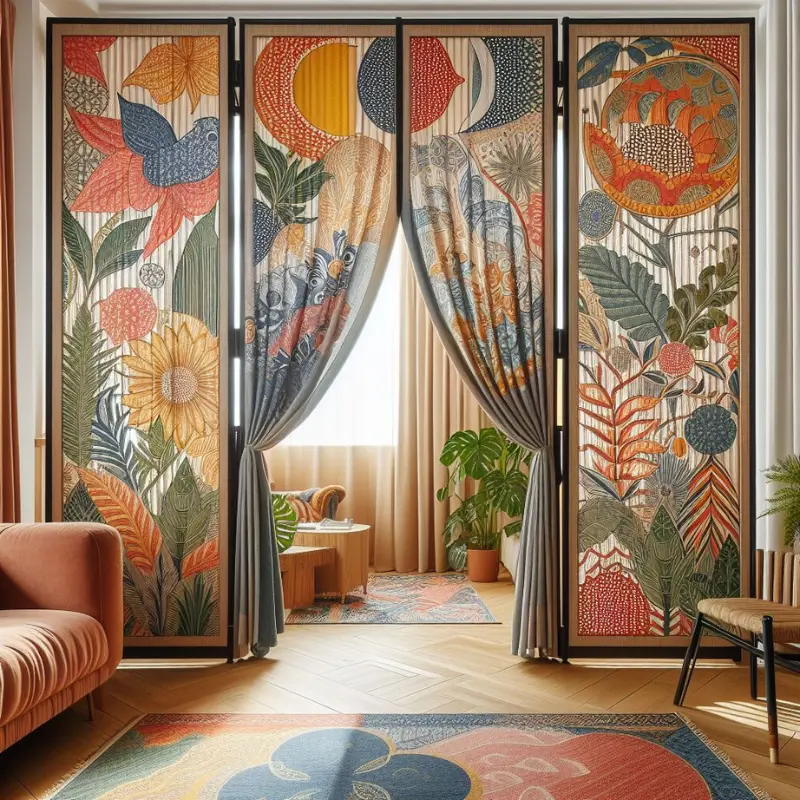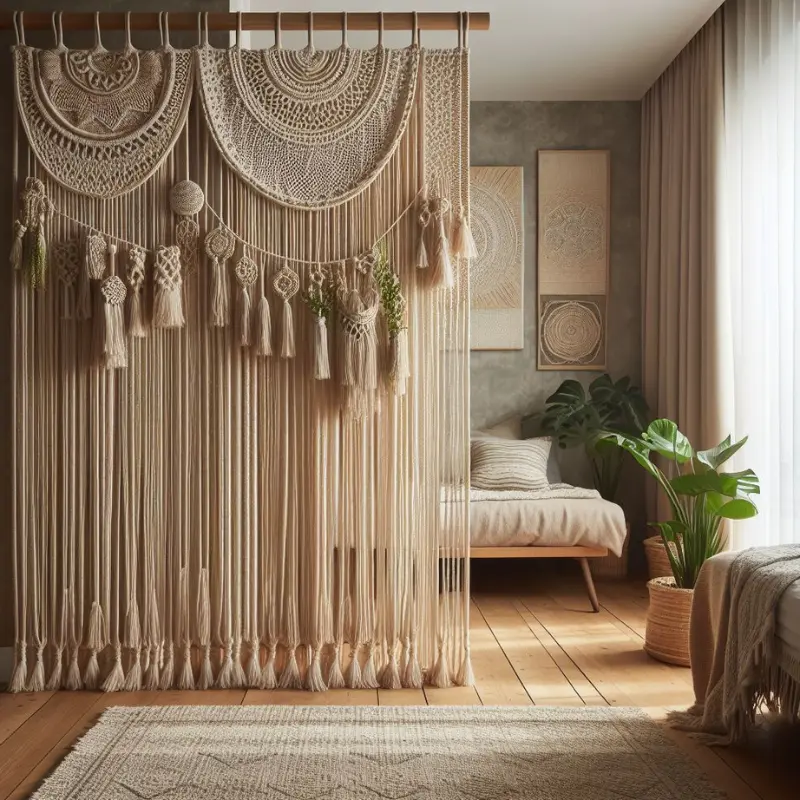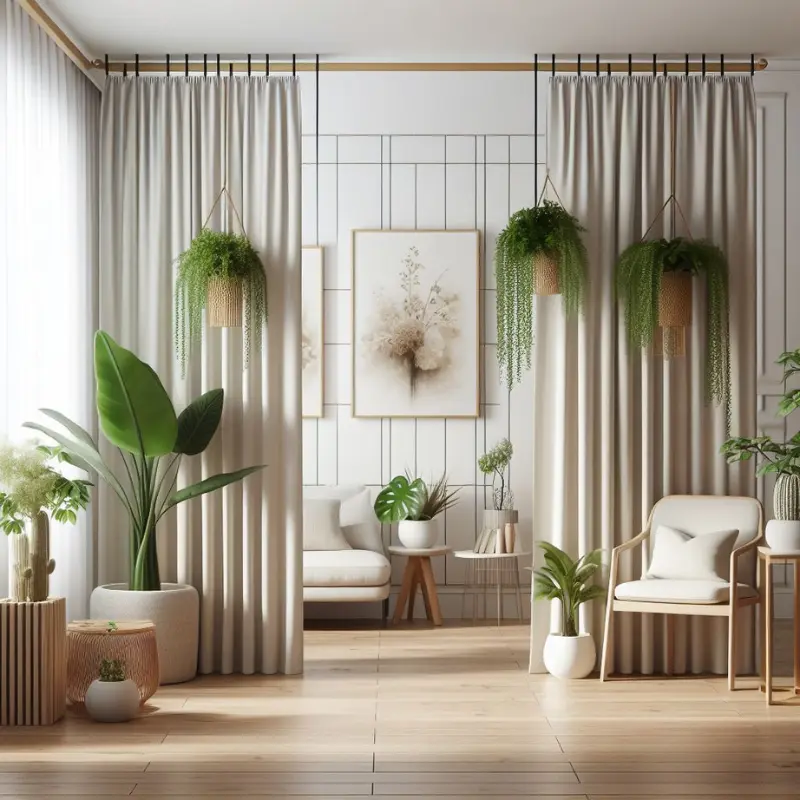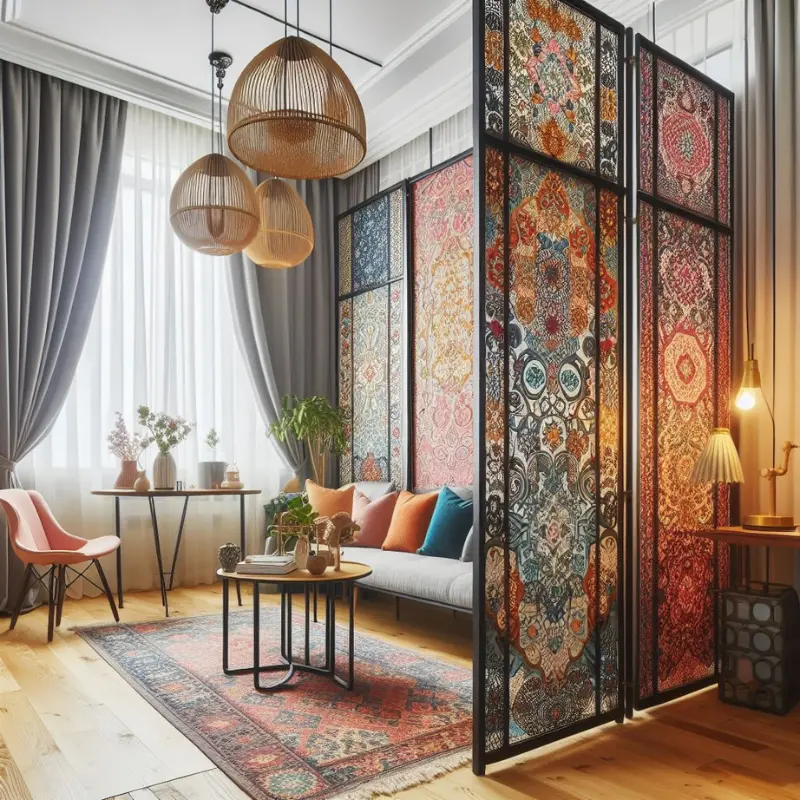Hey there, design enthusiasts! Have you ever looked at your open floor plan and thought, “This space could really use some definition”? Or maybe you’re a renter yearning for a dedicated workspace but stuck with a single room. Fear not, my friends! Today, we’re diving into the wonderful world of room dividers with curtains. Yep, those flowing fabrics you love on your windows can be transformed into clever space separators, adding both beauty and functionality to your home.
Now, before you race to the nearest fabric store, let’s explore the wonders of curtain room dividers. We’ll cover everything from the benefits they offer to creative design ideas and even some easy DIY projects.
So, grab a cup of tea, get comfy, and let’s unlock the magic of curtains as room dividers!

Why Use a Room Divider with Curtains?
There are many reasons why curtain room dividers might be the perfect solution for your space. Here are a few key benefits:
Flexibility
Unlike permanent walls, curtains offer amazing flexibility. Need to section off a guest sleeping area in the living room? Just draw the curtains! Feeling open and airy? Simply sweep them back. This adaptability is perfect for growing families, creative workspaces, or anyone who craves a space that can transform with their needs.
Affordability
Compared to building a wall or installing a screen, curtains are a budget-friendly option. You can find beautiful fabrics at a variety of price points, making it easy to fit your budget. Plus, most of us already have curtain rods lying around, saving you even more moolah!
Aesthetics
Let’s face it, curtains are inherently beautiful. They add a touch of softness and texture to a space, and depending on the fabric and color you choose, they can set a specific mood or style. From breezy sheers to dramatic velvets, the possibilities are endless!
Light Control
Depending on the fabric you choose, curtains can offer varying degrees of light control. Sheer curtains will allow diffused light to pass through, while blackout curtains can create a completely dark space – perfect for a makeshift home theater or a nap nook for little ones.
Privacy
Need a bit of privacy in your open-concept living space? Curtains can create a visual barrier, allowing you to carve out a dedicated space for work, relaxation, or even a dressing area.
Curtain Room Divider Ideas for Every Space
Now that you’re sold on the magic of curtain room dividers, let’s get creative! Here are some inspiring ideas for using curtains to section off different areas in your home:
Living Room Oasis
Do you dream of a cozy reading nook or a dedicated workspace in your living room? A curtain room divider can be your answer. Hang a sturdy curtain rod from the ceiling and choose a fabric that complements your living room decor. This creates a defined space without feeling heavy or closed off.
Studio Apartment Marvel
Living in a studio apartment can be tricky. But with a curtain room divider, you can create a sleeping area separate from your living space. Use a dark and opaque fabric to create a truly private sleeping environment.
Kitchen Magic
Is your kitchen a bit on the open side? A sheer curtain divider can subtly separate the cooking zone from the dining area. This helps to keep food smells at bay while still maintaining a sense of openness.
Kiddos Corner
Do your children share a room? Curtain room dividers can be a lifesaver! Divide the room in half to create separate sleeping areas or play zones for each child. Choose fun and colorful fabrics to match their personalities.
Home Theater Haven
Blackout curtains are your best friend when it comes to creating a home theater experience. They block out light completely, allowing you to fully immerse yourself in your favorite movies and shows.
DIY Curtain Room Divider Projects: Unleash Your Creativity!
Feeling crafty? Here are two simple DIY projects to create stunning curtain room dividers:
Project 1: The Elegant Linen Dream
Materials
- Curtain rod and brackets (ensure they can support the weight of your chosen fabric)
- Linen fabric (length should be based on your desired height and width of the divider)
- Fabric weights (optional, for added stability at the bottom hem)
- Sewing machine (optional, for a cleaner finish)
Instructions
- Measure the space where you want your curtain divider to hang.
- Purchase your curtain rod and brackets based on these measurements.
- If you want a finished look, hem the bottom of your linen fabric. You can use a sewing machine or iron-on hem tape for a no-sew option.
- Attach fabric weights (optional) to the bottom corners of the fabric. This will help the curtain hang straighter and prevent it from billowing too much.
- Install your curtain rod and brackets according to the manufacturer’s instructions.
- Slide your linen panel onto the curtain rod. For a more gathered look, you can use curtain rings with clips and bunch the fabric at even intervals before attaching it to the rod.
Project 2: The Bohemian Macrame Masterpiece
Materials
- Sturdy wooden dowel rod (length should be based on your desired width)
- Macrame cotton cord (length will depend on your desired length and number of macrame panels)
- Scissors
- Tape measure
Instructions
- Measure the space where you want your curtain divider to hang. Choose a dowel rod that’s slightly wider than this measurement.
- Learn some basic macrame knots! There are many online tutorials available to get you started with simple square knots and half square knots.
- With your macrame cord, create individual macrame panels using the knots you learned. You can make multiple panels to create a wider divider.
- Once you have your desired number of panels, attach them securely to the dowel rod. You can use a simple loop knot or braid the ends of the macrame cord to create a sleeve for the rod.
- Hang your macrame masterpiece! You can use sturdy curtain brackets or simply drill holes into the ends of the dowel rod and secure it directly to the wall (be sure to use appropriate wall anchors for this method).

Adding the Finishing Touches: Embellish Your Curtain Room Divider
Now that you have your beautiful curtain room divider in place, it’s time to personalize it! Here are some ideas:
- Trims and Tassels: Add a touch of elegance with decorative trims or tassels sewn onto the bottom hem of your curtains.
- Fairy Lights: String fairy lights along the top of the curtain rod for a touch of whimsy and soft lighting.
- Tie-Backs: Use decorative tie-backs to hold the curtains open when you want a more open feel. You can find beautiful tie-backs in various styles and materials to match your decor.
- Artful Touches: Feeling artistic? Hang a large piece of art or a dreamcatcher in the center of your curtain divider for a unique focal point.
Maintaining Your Curtain Room Divider
Just like your regular curtains, your curtain room divider will need some TLC from time to time. Here are some quick tips:
- Regular Dusting: Use a soft feather duster or vacuum cleaner attachment to remove dust and cobwebs.
- Washing: Depending on the fabric, you may be able to wash your curtains in a washing machine on a gentle cycle. Always check the care label for specific instructions.
- Ironing (Optional): If your curtains get wrinkled, you can iron them on a low heat setting (again, check the care label).
Curtain Room Dividers: A Functional and Beautiful Solution
Curtain room dividers offer a fantastic way to add flexibility, style, and function to your home, all without the commitment or expense of permanent walls. They’re a renter’s dream, allowing you to personalize your space and create designated areas for work, sleep, or relaxation. But their magic extends far beyond rentals. Open floor plans, a popular trend in modern homes, can sometimes feel overwhelming.
Curtain room dividers provide a gentle way to section off specific areas without sacrificing that sense of spaciousness. They can create a cozy reading nook in a living room flooded with natural light, or transform a studio apartment into a more functional living space.
The beauty of curtains lies in their adaptability. Need a workspace one day and a guest room the next? Simply draw the curtains! They offer the ultimate in flexible living, allowing you to transform your space to suit your ever-changing needs.
So, ditch the bulky screens and embrace the flowy magic of curtains. They’re a functional and beautiful solution that injects personality and style into any home.

Beyond the Basics: Advanced Curtain Room Divider Techniques
For those who crave a bit more design flair, here are some advanced techniques to elevate your curtain room divider:
- Double Curtain Drama: Create a layered look by using two curtain panels. Hang a sheer curtain closest to the window to allow light to filter through, and layer a more opaque curtain in front for privacy and visual interest.
- Track Systems for Flexibility: Consider using a track system instead of a single curtain rod. This allows you to stack the curtains to one side when you want a more open space. There are even curved track systems available to create a more rounded separation.
- Ceiling Mounted Majesty: For a more dramatic effect, mount your curtain rod directly onto the ceiling. This creates a sense of height and grandeur, perfect for large open spaces.
- French Door Flair: For a touch of Parisian charm, consider hanging your curtains from a decorative track system that resembles French doors. This adds a unique architectural element to your space.
Choosing the Right Fabric for Your Curtain Room Divider
The fabric you choose for your curtain room divider plays a crucial role in both function and aesthetics. Here are some key factors to consider:
- Light Control: Do you need complete privacy or just some light diffusion? Sheer fabrics like linen or voile will allow light to pass through, while blackout fabrics are perfect for blocking out light completely.
- Privacy: Consider how much privacy you need in the divided space. Opaque fabrics like velvet or densely woven cotton offer more privacy than sheer fabrics.
- Style: Match the fabric to your overall decor style. Linen offers a relaxed and natural look, while velvet adds a touch of luxury. You can also use patterned fabrics to add a pop of color or personality.
- Weight: Consider the weight of the fabric in relation to your curtain rod and brackets. Heavier fabrics like velvet will require sturdier hardware.
Cost Benefits of Using Curtains to Divide a Room
Let’s face it, creating separate spaces within your home can get expensive. Building permanent walls requires professional help and materials, significantly impacting your wallet. But fear not, design enthusiasts! Curtain room dividers offer a budget-friendly and stylish alternative.
Here’s why curtains reign supreme in the cost-effectiveness category:
Material Savings
Compared to drywall, lumber, and other construction materials needed for permanent walls, curtains are a steal. Fabric prices vary depending on quality and type, but you can find beautiful and functional options at a fraction of the cost of building a wall.
DIY Potential
Curtain room dividers are inherently DIY-friendly. In its simplest form, all you need is a curtain rod, some brackets, and your chosen fabric. With a little sewing know-how (or iron-on hem tape for a no-sew option), you can create a custom curtain divider that perfectly suits your space and style. Many online tutorials and resources can guide you through the process, saving you on labor costs.
Repurposing Power
We’ve all got those forgotten curtain panels stashed away in a closet. Consider giving them a new lease on life as a room divider! This is a fantastic way to upcycle existing materials and save money on buying new fabric.
Versatility Value
Unlike permanent walls, curtain room dividers offer incredible versatility. Need a workspace one day and a guest room the next? Simply draw the curtains! This adaptability ensures you get the most out of your investment. You can easily adjust the layout of your space without any additional construction costs.
A quick cost comparison to illustrate the point:
- Average Cost of Building a Wall (including materials and labor): $1,500 – $3,000+ (depending on size and complexity)
- Material Cost of DIY Linen Curtain Room Divider: $50 – $100 (including curtain rod, brackets, fabric)
- Material Cost of DIY Macrame Room Divider: $30 – $50 (including macrame cord, dowel rod)
As you can see, the cost savings with curtain room dividers are significant. Even if you factor in the price of pre-made curtains or blackout fabric for specific needs, it remains a much more affordable solution compared to permanent walls.
Beyond the initial cost, curtain room dividers offer long-term financial benefits:
Easy Maintenance
Unlike walls that may require occasional painting or repairs, curtains are relatively low maintenance. Regular dusting and occasional washing (depending on the fabric) will keep them looking fresh for years.
Move-Out Friendly
If you’re a renter, curtain room dividers are a dream come true. No need to worry about damaging walls or asking permission for alterations. Simply take down your curtains when it’s time to move on, leaving the space pristine.
So, the next time you’re considering dividing a space in your home, remember the magic of curtains! They’re a budget-friendly, versatile, and stylish solution that injects personality and functionality into any space.

Perspectives from Industry Experts and Professionals
So, what do the experts think about this idea of using curtains as a room divider? Let’s hear from some professionals who have seen the power of these versatile and budget-friendly solutions firsthand:
“Curtain room dividers are a fantastic tool for adding both function and style to a space. I love using them in open floor-plan living areas to create a more intimate conversation nook or a dedicated home office area. My favorite tip? Have fun experimenting with colors and patterns! A bold patterned curtain can become a gorgeous focal point in a room.”
– Interior Designer – Sarah Jones, Founder of “Light & Space” Interiors
“From a home staging perspective, curtain room dividers can be a lifesaver, especially in small apartments or studios. They allow us to visually define separate areas like a sleeping space and a living area, making the space feel more organized and appealing to potential buyers. When staging, I recommend using neutral-colored sheers to maintain a sense of openness while still achieving some separation.”
– Home Stager – David Lee, Owner of “Elevated Homes” Staging
“As an architect, I appreciate the flexibility that curtain room dividers offer. They allow for a more dynamic use of space compared to permanent walls. In some of my projects, we’ve designed rooms with tracks built into the ceiling, allowing for curtains to completely disappear when not in use. This creates a seamless transition between open and divided spaces.”
– Architect – Maria Garcia, Principal at MG Designs
“For me, the beauty of curtain room dividers lies in the endless creative possibilities they offer. I love working with clients to create custom macrame or woven panels that function as room dividers while showcasing their unique style. Texture and color add another dimension to the space, making the divider itself a piece of art.”
– Textile Artist – Amelia Johnson, Owner of “Woven Wonders” Studio
“Curtain room dividers are a budget-friendly and renter-friendly way to personalize your space. There are so many DIY projects you can tackle! From sewing simple linen panels to creating boho-chic macrame dividers, the possibilities are endless. My blog is full of inspiration and tutorials to help you create a beautiful and functional curtain room divider for your home.”
– DIY Enthusiast & Blogger – Michael Chen, Creator of “Crafty Homemaker” Blog
Real-Life Examples and Case Studies
Although the advantages and factors have been discussed, how do curtain room dividers actually benefit the lives of normal people? Let’s hear from a few of them:
The Work-From-Home Oasis: Jessica, Marketing Manager
“Working from home sounded like a dream until I realized my one-bedroom apartment offered zero separation between my workspace and my relaxation zone. A sheer curtain divider was a game-changer! I hung a track system across the room and used a light, linen curtain. Now, I can draw the curtain closed to create a focused workspace during the day, and easily open it back up in the evening to reclaim my entire living space.”
The Studio Apartment Sanctuary: David, College Student
“Living in a studio apartment can feel cramped, but a strategically placed curtain divider made all the difference for me. I used a dark blackout curtain to section off a sleeping area, giving me a private space to unwind after a long day. The best part? The curtain folds back neatly during the day, keeping the studio feeling open and airy.”
The Multi-Functional Living Room: Sarah & Michael, Young Couple
“Our living room is quite spacious, but we also wanted a cozy nook for reading and movie nights. We installed a sturdy curtain rod and hung a velvet curtain in a rich jewel tone. Now, we can draw the curtain to create a warm and inviting reading area, perfect for curling up with a good book or enjoying a movie marathon.”
The Playful Pixels: Emily, Mom of Two
“Keeping playtime contained can be a challenge, especially with two young kids sharing a room. Curtain dividers came to the rescue! We hung colorful curtains across the room, dividing the space into a dedicated sleeping area and a play zone. It allows the kids some privacy for sleep time while still keeping an eye on them during playtime.”
The Open Kitchen, Defined: Jason, Home Chef
“I love to cook, but sometimes kitchen odors tend to waft into the living room. A sheer curtain divider did the trick! It separates the kitchen area from the living space without feeling too closed off. I can cook up a storm without worrying about lingering smells, and the curtain adds a touch of softness to the open floor plan.”
My Experience as a Homeowner: Curtain Magic Transforms My Living Room
As a homeowner myself, I can wholeheartedly vouch for the transformative power of curtain room dividers. My living room is a spacious open area, which I love for its airiness and natural light. However, sometimes I craved a cozy nook for curling up with a good book or enjoying a movie marathon without feeling like I was taking over the entire space.
That’s when the curtain divider idea struck! I opted for a simple DIY approach. I found some beautiful, textured linen fabric at a local fabric store and used an existing curtain rod I had lying around. With a quick trip to the hardware store for some brackets and some basic sewing skills, I created a stunning linen panel. Mounting the rod and hanging the curtain was a breeze – the whole project took less than an afternoon!
The impact was incredible. The linen curtain softly separates a dedicated reading area without feeling too heavy or closing off the entire space. When I want a completely open living area, all I need to do is simply sweep the curtain back. This flexibility is what I love most! It allows my living room to adapt to my needs, offering both a spacious communal area and a cozy retreat whenever the mood strikes.
Not only did the curtain divider add functionality, but it also injected a touch of personality into my space. The textured fabric adds a visual element that complements my existing decor. It’s a constant reminder that sometimes, the simplest solutions can have the most dramatic impact.
So, if you’re looking for a way to create separate areas within your home without breaking the bank or committing to permanent changes, I highly recommend giving curtain room dividers a try. You might be surprised by the magic they can create!

References and Resources
Now, we’ll explore some reputable sources and resources related to using curtains as room dividers:
- National Association of Home Builders (NAHB): The NAHB is a leading authority on the residential construction industry. While their website doesn’t offer specific articles on curtain room dividers, they frequently discuss open floor plans and space optimization techniques. Understanding these concepts aligns with the functionality of curtain room dividers in modern homes.
- American Society of Interior Designers (ASID): The ASID is a professional organization for interior designers. Their website offers a wealth of resources on interior design trends and best practices. While they may not have dedicated articles on curtain room dividers, exploring their content on space planning and creating functional living areas can provide valuable insights into utilizing curtains for room division.
- Psychology of Open Floor Plans: Benefits and Drawbacks: This article from Apartment Therapy, a reputable source on interior design and home improvement, delves into the psychological aspects of open floor plans. Understanding the potential drawbacks of open spaces, such as a lack of privacy or difficulty defining separate areas, strengthens the case for using curtain room dividers as a solution.
- 10 Space-Saving Room Divider Ideas: This resource from The Spruce, another well-respected website on home decor and DIY projects, showcases various room divider options, including curtains. It highlights the advantages of curtains, like affordability and versatility, compared to other space-saving solutions.
Discussions and Forums
Conclusion
With a little planning and creativity, curtain room dividers can transform your space into a haven of functionality and style. They offer a budget-friendly and versatile solution for anyone looking to create separate areas within their home. So, don’t be afraid to experiment with different fabrics, designs, and techniques. Embrace the magic of curtains and unlock the full potential of your open space!
I hope this blog post has inspired you to explore the world of curtain room dividers. If you have any questions or suggestions, feel free to leave a comment below. Happy decorating!
Also read – How to Repurpose Old Fabrics into Stunning Throw Pillows
Frequently Asked Questions
Q.1 – What kind of fabric should I use for a room divider curtain?
The best fabric for your room divider curtain depends on your needs. Here’s a quick breakdown:
- Light Control: Sheer fabrics like linen or voile allow light to pass through, while blackout fabrics block light completely (perfect for bedrooms or home theaters).
- Privacy: Opaque fabrics like velvet or densely woven cotton offer more privacy than sheers.
- Style: Match the fabric to your decor! Linen offers a relaxed look, velvet adds luxury. Consider patterned fabrics for a pop of personality.
- Weight: Heavier fabrics like velvet require sturdier hardware to support them.
Q.2 – How wide should my curtain room divider be?
The ideal width depends on the space you’re dividing. Aim for a width that comfortably covers the area you want to section off, with a little extra room on either side for gathering if desired. Consider adding a few inches to the width to account for any hardware you’ll be using to hang the curtains.
Q.3 – Can curtain room dividers block out sound?
While they won’t completely eliminate sound, certain fabrics can help dampen noise. Thicker fabrics like velvet or soundproof curtains specifically designed for noise reduction will offer the best sound absorption.
Q.4 – Are curtain room dividers difficult to install?
Not at all! Installing a curtain room divider is a relatively simple process. You’ll need to mount a curtain rod or track system (depending on your preference) and then hang your curtains. Most hardware comes with clear instructions, and many online tutorials can guide you through the process.
Q.5 – How can I clean my curtain room divider?
Cleaning your curtain room divider depends on the fabric. Most fabrics can be dusted regularly with a soft feather duster or vacuum cleaner attachment. Check the care label for washing instructions; some fabrics may be machine washable, while others might require dry cleaning.
Do you have any creative ideas for using curtain room dividers? Share them in the comments below!
*Images used in this blog post article are for illustrative purposes only. We do not possess any copyrights to these images unless explicitly mentioned.

Nikhil Shukla
About The Author
Nikhil, with a background in Technology, is deeply passionate about Interior Design and Home Décor. At Cherry Hills Home Living, he channels this passion into creating inviting and stylish living spaces. With a unique blend of analytical thinking and creative flair, Nikhil offers innovative ideas, practical tips, and inspiring guidance to help others transform their homes into cozy retreats.